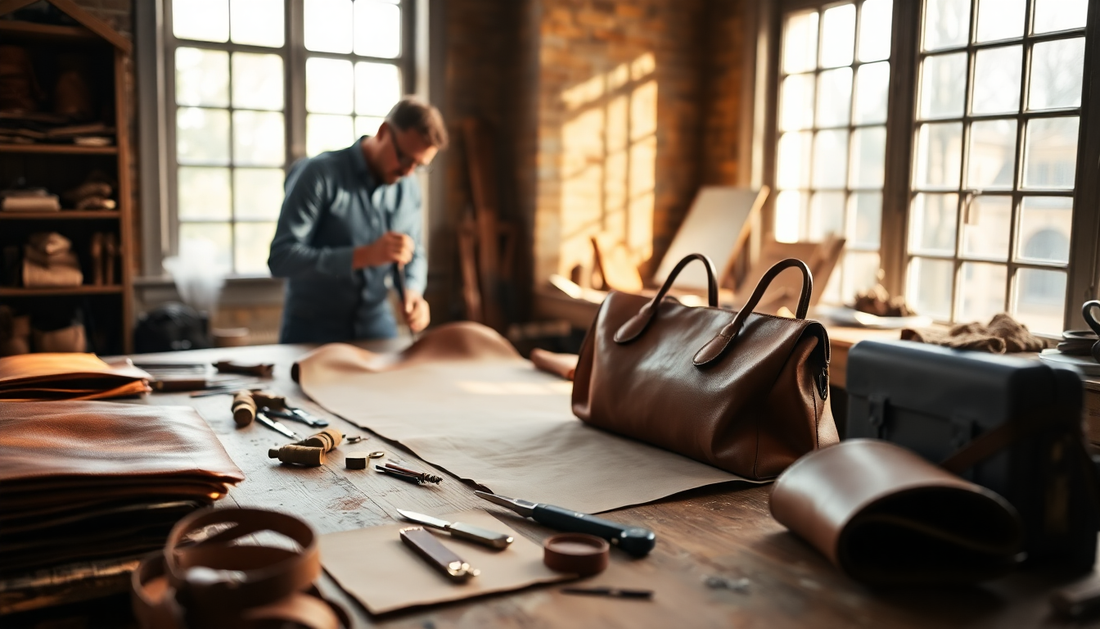
Crafting the Perfect Leather Bag: A Clear, Expert Guide to Choosing Your Ideal Accessory
At a glance: Learn how to pick leather that lasts, choose the right size and structure for your day, match color to your wardrobe, and shop four editor-approved LeatherLuxe picks—each with detailed specs.
Who this guide is for
Whether you’re buying your first leather bag or refining a collection, this guide breaks down materials, structure, size, and styling so you can choose a piece you’ll carry for years. We’ve also included quick checks (phone and essentials fit), strap-drop tips, and care pointers to keep your investment looking pristine.
Step 1 — Know your leather (durability, feel, patina)
Full-grain vs. top-grain: what’s the difference?
- Full-grain leather: Uses the hide’s outermost grain with natural markings intact; it’s celebrated for strength, breathability, and a rich patina that deepens over time.
- Top-grain leather: Taken from the upper portion of the hide and lightly corrected for a smoother, more uniform surface—balanced durability with a refined look.
Why this matters: Both full-grain and top-grain are premium choices. Full-grain prioritises character and long-term patina; top-grain emphasises a sleek finish while staying robust for daily wear.
Choosing a finish and texture
- Natural pebble/pebble-embossed: Hides scuffs well; easy everyday option.
- Croc-style emboss: Adds structure and visual depth; pairs well with smart-casual or polished office looks.
- Soft vs. structured: Soft leathers drape and feel plush; structured leathers hold a crisp silhouette (ideal when you want your bag to stand up on its own).
Thickness in practice
For most handbags and small leather goods, mid-weight leathers deliver the sweet spot: supple in hand yet sturdy enough to protect contents and keep edges neat. If you prefer a more protective, stand-up silhouette, choose styles with a slightly firmer hand and reinforced paneling.
Step 2 — Structure & organisation (how the bag behaves in real life)
- Main compartments: Dual-zip or tri-compartment layouts help separate tech, wallet, and keys.
- Quick-access pockets: A back zip or exterior slip pocket saves time for transit cards, phone, or receipts.
- Security: Zippers or lockable sections are best for commutes and travel-through days.
Tip: If you carry small items (lip balm, AirPods, mints), look for one interior zip plus at least one slip pocket to avoid rummaging.
Step 3 — Size & capacity (what actually fits)
Everyday check: Will it comfortably fit your phone, wallet, keys, sunglasses, and a small cosmetics pouch without bulging?
- Compact/Small: Streamlined carry for phone + slim wallet + keys. Perfect for dinner, errands, or event days.
- Medium: Adds space for sunglasses case and a small notebook without feeling bulky.
- Work/Day-to-night: Choose a structured medium with smart partitioning so it stays tidy from desk to dinner.
Phone fit tip: Large-format phones (e.g., iPhone Pro Max) need a clear compartment width of ~77 mm (plus case) and height ~160 mm; a dedicated phone slot is ideal for quick access.
Step 4 — Comfort & carry (handles, strap, weight)
- Top handle + detachable strap: Most versatile for desk to dinner.
- Strap drop: For on-shoulder comfort, a drop around 25–55 cm (adjustable) typically suits most heights and outerwear layers.
- Weight: If you commute, aim for lighter base weight plus supportive strap width to avoid shoulder fatigue.
Step 5 — Colour that works hard in your wardrobe
- Core neutrals: Cream, beige, tan, and black integrate with almost everything.
- Accent tones: Deep reds and greens read premium while adding personality—great with denim, blacks, creams, and navy.
- Hardware match: If you wear gold-tone jewellery, warm metals harmonise; cool hardware pairs nicely with silver jewellery and navy/grey wardrobes.
Quick Tips
- Prefer full-grain for long-term patina; choose top-grain for a smoother, more uniform look.
- Check closure security (zips, lockable flaps) for commutes and travel.
- Use the phone fit check (especially for larger phones) before you buy.
- Pick a detachable/adjustable strap for maximum versatility.
- Store in a dust bag and condition periodically to extend life.
Editor-approved LeatherLuxe picks




How to choose your bag in 3 minutes (step-by-step)
- Pick your leather feel: Want character and patina? Go full-grain (clutches and forever totes). Want sleek utility? Choose top-grain (structured satchels, work bags).
- Choose structure for your day: If you commute, look for zipped or lockable compartments; for event evenings, a clutch with a phone compartment keeps things minimal and neat.
- Check the fit: Do a quick phone/wallet/keys test. Medium satchels offer the most day-to-night flexibility.
- Dial in color + hardware: Neutrals for maximum wear; rich reds/greens to add depth to a capsule wardrobe.
- Future-proof with care: Store in a dust bag, avoid overstuffing, and condition periodically.
Care & longevity (fast routine)
- Daily: Wipe with a dry, soft cloth; avoid overloading and harsh rubs against textured coats.
- Monthly: Brush seams/edges gently and spot-clean with a leather-appropriate cleaner.
- Seasonal: Condition sparingly (thin, even layer), let it absorb fully; store upright with light stuffing.
Want a deeper dive? Explore the LeatherLuxe guide: How to Care for Your Leather Goods.
FAQ
- What’s the difference between full-grain and top-grain leather?
- Full-grain retains the hide’s natural grain for maximum strength and patina potential; top-grain is lightly corrected for a smoother, more uniform surface while remaining durable for daily use.
- How do I know if my phone will fit?
- Check your phone’s official height and width and compare to the product’s phone compartment or main opening. For large phones like iPhone Pro Max, look for a compartment height ~160 mm and width ~77 mm or greater.
- What’s the easiest way to keep my leather bag looking new?
- Keep it clean and dry, store in a dust bag, avoid prolonged sun/heat, and condition occasionally with a leather-appropriate conditioner—light applications work best.
- Which bag style suits a minimalist wardrobe?
- Choose structured, medium silhouettes in core neutrals (cream, beige, tan, black). They style with everything and stay polished from day to night.
